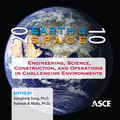Arctic and Antarctic Analogs for Planetary Surface Traverses
Publication: Earth and Space 2010: Engineering, Science, Construction, and Operations in Challenging Environments
Abstract
The proposed paper summarizes a recent (August 2009) workshop at the NASA Johnson Space Center discussing lessons learned from traverses, driven largely by science objectives, in the Earth's polar regions. These lessons will be used as one facet of NASA's preparation to explore, over extended periods of time, the surface of the Moon and Mars as part of the Constellation Program. Over 50 years of extensive traverses in both the Arctic and Antarctic provide a potentially rich source of lessons for future planetary missions under analogous conditions. For both lunar and Mars missions, it is anticipated that both crew and robotic equipment, which could arrive on different vehicles, will land in a fairly benign location. But "benign" can also translate into "uninteresting" from a scientific or exploration perspective, resulting in the crew exhausting the scientific potential of a particular site before returning to Earth. This is especially true for Mars mission crews who will spend 18 months at a given location. By providing a capability to move long distances across the surface removes the need to risk a landing at a more challenging, but interesting, surface location. The proposed paper summarizes the workshop presentations and discusses several of the key findings or lessons, including: (1) A recognition that NASA's current approach for long duration planetary surface operations has fundamental differences from any of the operational approaches described by the invited speakers. These approaches drive the crew size and skill mix to accomplish basic objectives and, in turn, drive the logistical pyramid needed to support these operations. NASA will review the operational approaches of the organizations represented to understand the differentiating factors. NASA will then decide if it should alter its current approach to surface exploration. (2) There are potential parallels between key characteristics of the systems used for exploration in these environments, such as heated volume as an analog for pressurized volume or energy usage for various activities. NASA will look at these characteristics to identify which could help with preliminary planning and gather raw data from the presenters to model these characteristics. (3) New technologies are being applied and design approaches are being tailored to take advantage of these technologies on both sides. Interactions between these two communities has begun or is expanding to understand how these new technologies are being leveraged: NASA habitation designers are exchanging ideas and approaches with the Antarctic station designers; Antarctic support contractors have put together a list of areas where NASA could benefit from their experience and vice versa; discussions have begun to compare the equipment used for the National Science Foundation (NSF) South Pole Station resupply traverses to identify possibly functional similarities for NASA.
Get full access to this chapter
View all available purchase options and get full access to this chapter.
Information & Authors
Information
Published In
Copyright
© 2010 American Society of Civil Engineers.
History
Published online: Apr 26, 2012
Authors
Metrics & Citations
Metrics
Citations
Download citation
If you have the appropriate software installed, you can download article citation data to the citation manager of your choice. Simply select your manager software from the list below and click Download.
